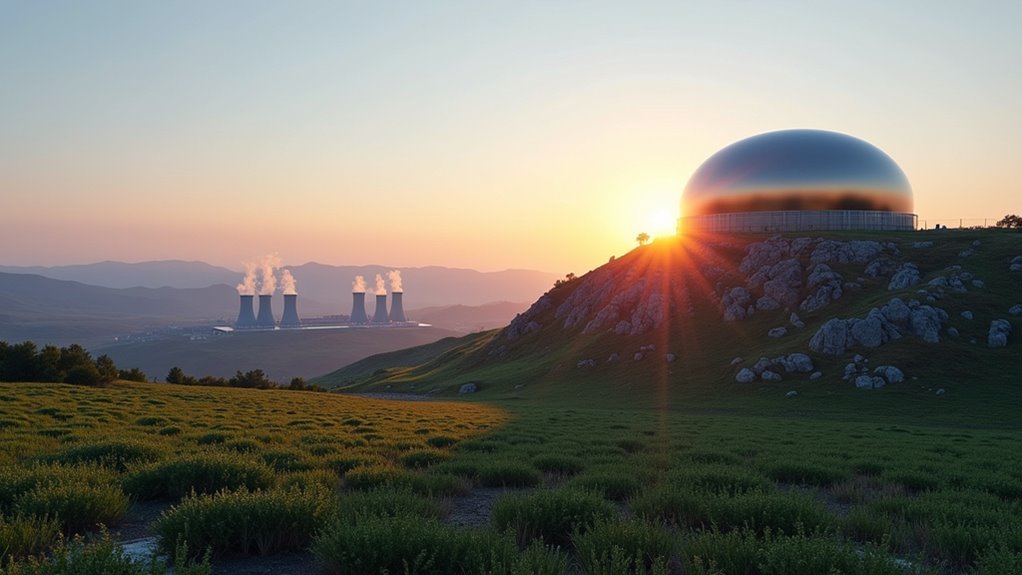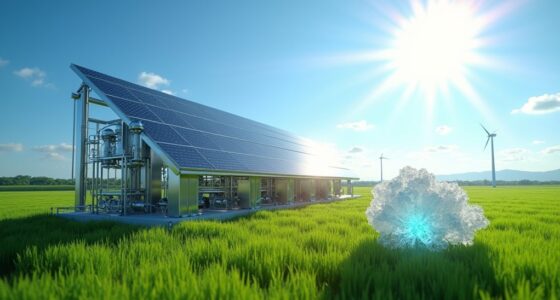Small Modular Reactors (SMRs) offer a cleaner, safer way to produce nuclear energy. Their compact, factory-built design speeds up deployment, reduces costs, and allows flexible scaling to meet various needs. With advanced safety features like passive cooling and underground siting, SMRs minimize risks and improve security. They can help cut carbon emissions while creating jobs and boosting local economies. If you want to explore how SMRs can power a greener future, there’s more to uncover.
Key Takeaways
- SMRs offer enhanced safety features like passive cooling and underground siting, reducing accident risks and environmental impacts.
- Modular design accelerates deployment, enabling cleaner energy generation faster than traditional reactors.
- Factory fabrication ensures high-quality construction with fewer emissions and waste, supporting cleaner nuclear energy production.
- SMRs can provide reliable low-carbon power for various applications, complementing renewable energy sources.
- Their smaller size and flexible siting minimize land use and environmental footprint, promoting cleaner energy solutions.
Understanding Small Modular Reactors and Their Unique Advantages
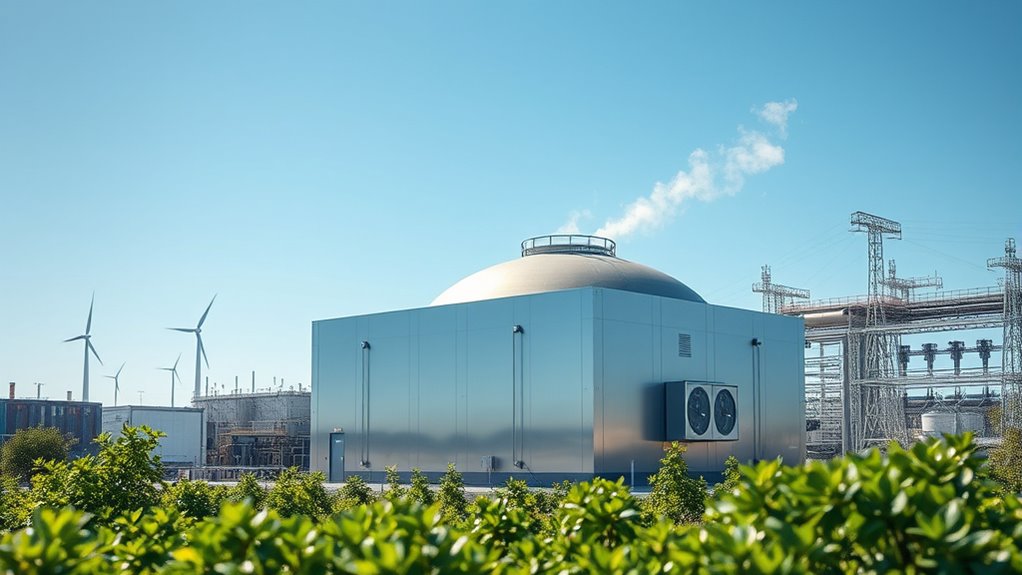
Small Modular Reactors (SMRs) are revolutionizing nuclear energy by offering a simpler, more flexible alternative to traditional reactors. Their compact design makes them easier to build and maintain. Factory fabrication guarantees consistent quality and speeds up deployment, reducing construction time from up to 12 years to about 3 years.
Modular construction allows you to add capacity gradually, matching demand and improving investment flexibility. SMRs include passive safety systems that operate without human intervention, lowering accident risks.
Their smaller cores produce less heat and are often housed underground or within reinforced structures, boosting security and resilience. You can site SMRs in remote or small-grid areas, requiring less land and infrastructure. As of early 2024, only five SMRs are operational worldwide, highlighting the industry’s nascent stage. Their scalable size and adaptable output help meet regional energy needs while supporting a cleaner transition away from fossil fuels.
Cost-Effective Solutions for Modern Energy Demands
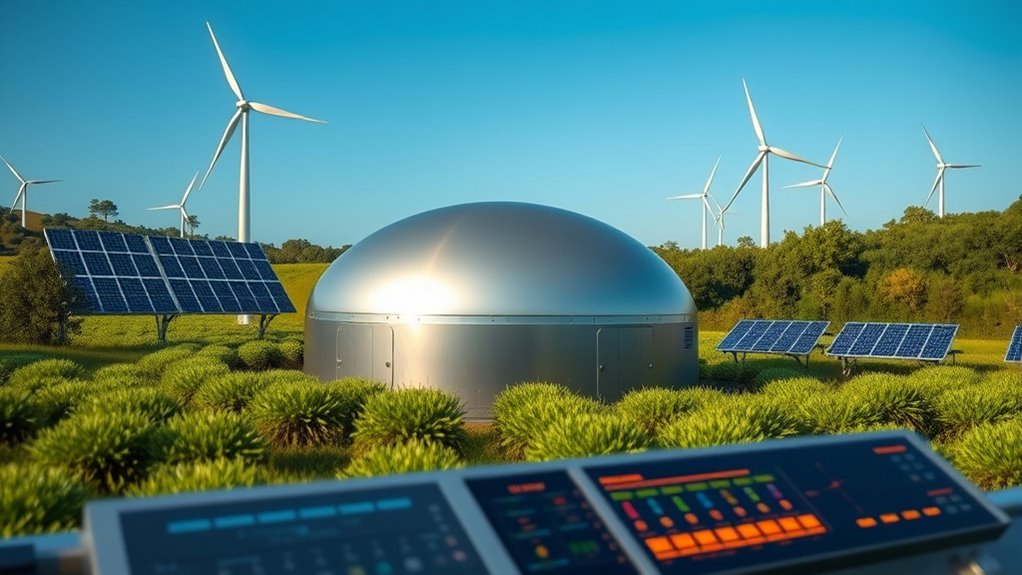
Because they require a smaller initial investment, SMRs present a cost-effective solution for meeting modern energy demands. Their modular factory fabrication cuts construction costs by standardizing components, while smaller size reduces site prep and infrastructure expenses. Additionally, SEER ratings help evaluate the cooling efficiency of associated systems, ensuring optimal performance. This lower upfront cost makes SMRs accessible to utilities with limited budgets or smaller grids. Their scalability allows you to add capacity incrementally, matching demand growth without overcommitting. You can also site SMRs in locations unsuitable for larger reactors, increasing deployment flexibility. Cost modeling shows SMRs can be competitive, especially with streamlined designs and repetitive manufacturing. As experience grows, costs decrease further by reducing technical risks and delays. Innovations like high-fidelity modeling and advanced materials promise ongoing savings, making SMRs a practical, economical choice for modern energy needs.
Accelerating Deployment for Immediate Energy Needs
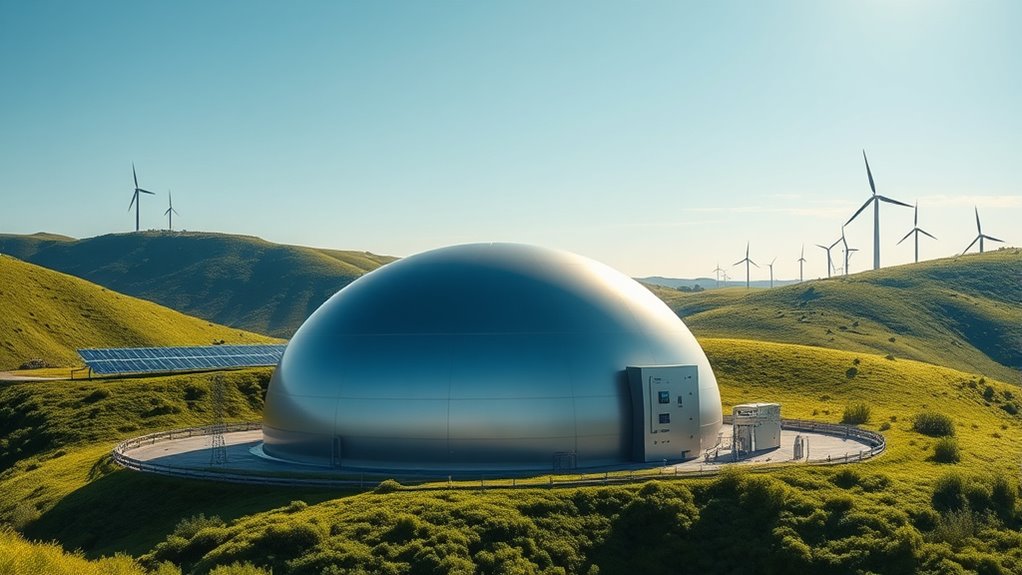
How can we speed up SMR deployment to meet urgent energy demands? You can help by supporting collaborative frameworks that align stakeholders across financing, risk management, and regulation. Public and private investments are essential, especially for first-of-a-kind units planned for the 2030s, so advocating for increased funding can accelerate progress. Streamlining regulatory processes and aligning standards will reduce delays and costs, making deployment more feasible. Addressing supply chain challenges, such as standardizing components and expanding manufacturing capabilities, is vital for timely construction. International cooperation can also bolster supply chains and workforce development. Over 120 nuclear companies and 25 countries have committed to tripling global nuclear capacity by 2050, which underscores the urgent need for accelerated deployment. Recognizing the importance of regulatory compliance can facilitate smoother licensing processes and reduce potential delays. With these strategies, SMRs can be deployed faster, providing reliable, low-carbon energy that meets immediate needs while paving the way for broader global adoption.
Enhancing Safety and Security in Nuclear Power
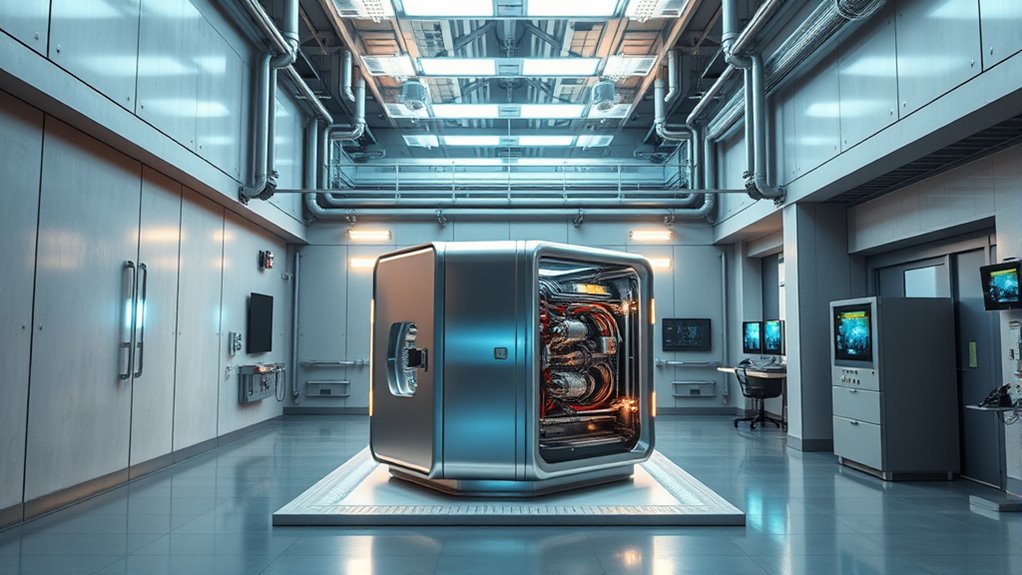
As efforts accelerate to deploy SMRs rapidly to meet urgent energy needs, ensuring their safety and security becomes even more vital. Passive safety systems play a pivotal role by operating without human intervention or electrical power, increasing reliability during emergencies. Natural circulation cools the core, removing reliance on active components like pumps, while fewer valves, pipes, and cables reduce failure points. Modern safety protocols and technological advancements further enhance the safety profile of SMRs, making them more resilient against potential hazards. SMRs can shut down and self-cool indefinitely, providing longer reaction times for operators. Design features, like underground siting and reinforced structures, limit damage from external threats such as earthquakes and sabotage. Smaller containment systems and reduced emergency zones lower risks and response costs, but require careful safety management to prevent vulnerabilities. Incorporating passive safety features is essential to improve overall resilience and public confidence in next-generation nuclear technologies.
Flexibility and Scalability for Diverse Applications

The inherent modularity and factory production processes of SMRs enable remarkable flexibility and scalability for a wide range of applications. Because they’re built in standardized modules, you can quickly produce large quantities with consistent quality, reducing on-site construction time and costs. Power capacity up to 300 MW(e) per unit, allowing for tailored energy solutions that can be expanded as needed. This modular approach allows you to add capacity gradually by deploying multiple units as needed, tailoring power output to specific community or industrial demands. Their compact size and lower infrastructure needs mean you can site them in remote or limited-space locations, including small or isolated grids. You can also use SMRs for diverse purposes like process heat, district heating, or off-grid power. Modular design supports energy transitions, industrial decarbonization, and economic growth, all while adapting to changing energy needs over time.
Environmental Benefits and Contribution to Sustainable Energy Goals
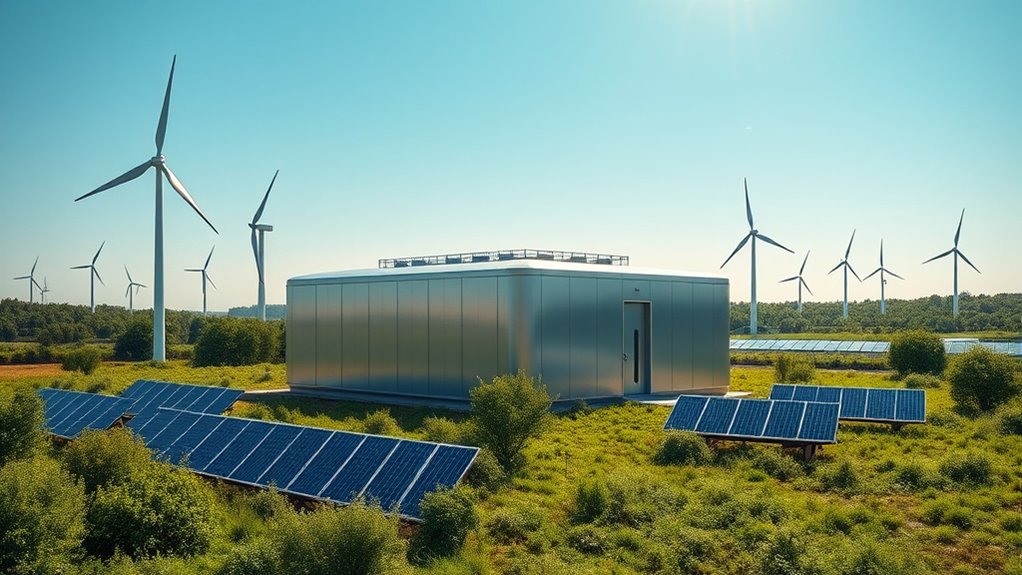
Are small modular reactors truly transforming the energy landscape by offering significant environmental benefits? They produce electricity with minimal greenhouse gases, supporting climate goals and reducing pollution-related fatalities compared to fossil fuels.
Their efficient design means less fuel use and longer intervals between refueling, cutting operational emissions. SMRs require much less land—just a fraction of that needed for traditional reactors—allowing installation on smaller sites or repurposed industrial areas, which conserves land and minimizes ecological disruption.
Their passive safety features and underground installation options lower the risk of accidents and environmental contamination. Additionally, SMRs help expand clean energy access in developing regions, promoting energy equity and security. Small Modular Reactors are also capable of utilizing advanced fuel recycling techniques, further enhancing their environmental sustainability and contribution to global decarbonization efforts.
With less nuclear waste per energy unit and potential for advanced fuel recycling, SMRs advance environmental sustainability and global decarbonization efforts.
Economic Opportunities and Job Creation in the Nuclear Sector
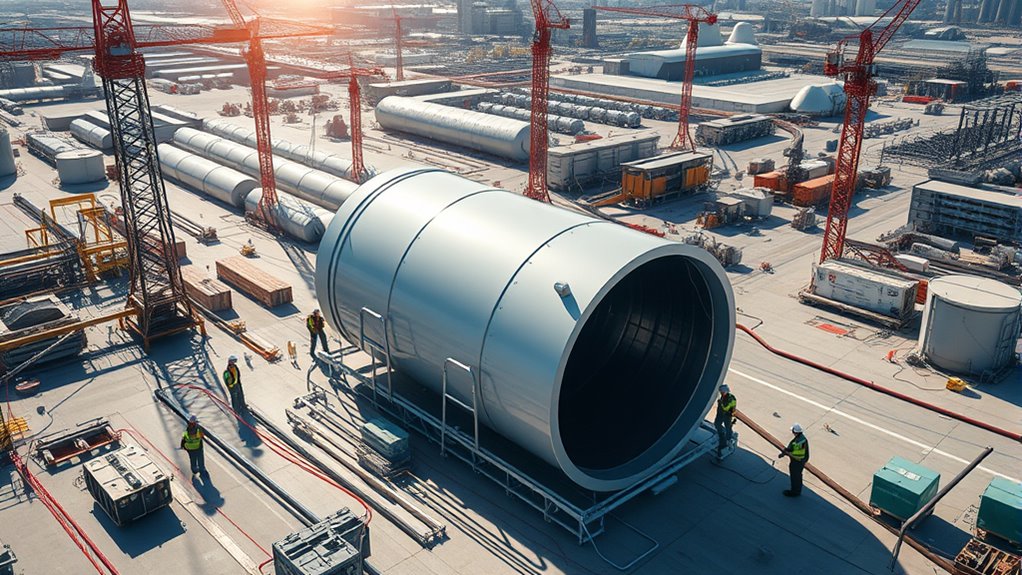
Deploying small modular reactors (SMRs) offers substantial economic opportunities by creating thousands of jobs across construction, manufacturing, and operational phases. A single 100 MW SMR can generate about 7,000 jobs, boosting local economies through direct, indirect, and induced employment.
Factory fabrication of modular parts concentrates skilled labor in advanced manufacturing facilities, fostering industry growth. The shorter construction timeline—around three years—means quicker employment boosts compared to traditional plants.
Once operational, SMRs require ongoing staffing for maintenance, security, and management, supporting long-term community employment. Additionally, SMRs lower upfront costs thanks to modular design and factory fabrication, making projects viable in smaller or developing markets.
This approach also opens avenues for export, innovation, and regional revitalization, fueling broader economic growth and diversification. Regulatory frameworks ensure safe and compliant deployment of nuclear technologies, further supporting industry expansion.
Frequently Asked Questions
What Are the Main Regulatory Challenges Facing SMR Deployment Worldwide?
You face regulatory challenges with SMR deployment worldwide, like outdated rules designed for large reactors that don’t fit SMRs’ unique features. Licensing is costly and slow, discouraging new entrants.
Safety, security, and environmental standards need early integration into design phases.
Variations in international regulations hinder global coordination, and high compliance costs limit investments.
To succeed, you’ll need streamlined, harmonized regulations and supportive policies that encourage innovation while ensuring safety.
How Do SMRS Compare to Renewable Energy Sources in Cost and Scalability?
Think of building a small boat versus a fleet of solar panels; each has strengths. SMRs cost around $94 per megawatt-hour, while solar drops to about $30 by 2030.
SMRs are flexible and scalable with smaller sizes, but solar easily deploys in large arrays.
If speed and cost are your priority, solar wins. SMRs offer steady power, but renewable sources often provide quicker, cheaper solutions for large-scale energy needs.
What Are the Long-Term Waste Management Considerations for SMRS?
You need to take into account that SMRs produce more reactive waste and higher volumes than traditional reactors, making long-term storage complex. Waste management costs might offset initial savings, and developing specialized infrastructure is essential.
You should also evaluate environmental impacts and guarantee containment for hundreds of thousands of years. Collaborating internationally and investing in research will help you address these challenges and improve waste disposal strategies effectively.
How Does Public Perception Influence SMR Adoption and Acceptance?
Can you picture communities welcoming new technology or hesitating due to concerns? Your perception plays a crucial role in SMR adoption.
When you understand the safety, environmental, and economic benefits, you’re more likely to support it. Effective communication, community involvement, and transparency build trust.
If you see SMRs as safe and beneficial, you’re helping drive acceptance, making cleaner, innovative energy a reality for everyone.
What Are the International Safety Standards for SMRS and Their Harmonization?
You want to understand how international safety standards for SMRs are harmonized. The IAEA develops adaptable safety guidelines, involving experts from around the world to identify gaps and update standards for SMRs.
They focus on lifecycle safety, security, and safeguards, promoting cooperation and module certification. By establishing consistent safety criteria, they aim to streamline licensing, support cross-border deployment, and ensure that SMRs meet high safety standards globally.
Conclusion
You might worry small modular reactors are just a fad, but they offer real, scalable solutions for cleaner energy. With their safety features, environmental benefits, and potential to create jobs, SMRs can help meet your community’s energy needs responsibly. Embracing this technology doesn’t mean sacrificing safety or affordability—it’s about choosing a sustainable path forward. By supporting SMRs, you’re investing in a safer, greener future that benefits everyone.
